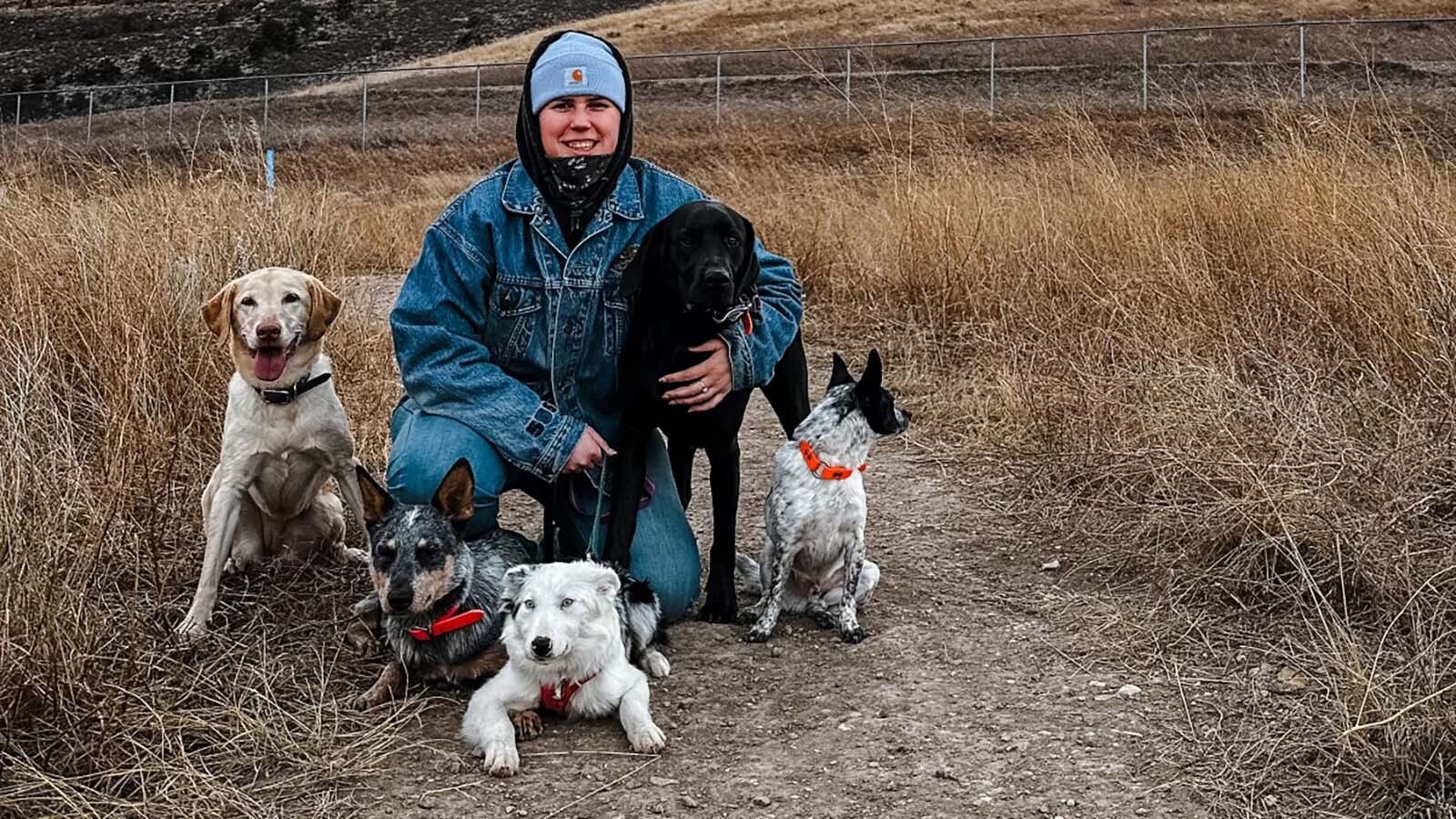When a unique piece of Wyoming’s indigenous history was vandalized and stolen, Wyomingites rallied to ensure it wasn’t lost forever.
That's how the Great Turtle Shield, a petroglyph from the Castle Gardens Petroglyph Site south of Moneta and U.S. Route 26 in Fremont County, ended up at the Wyoming State Museum in Cheyenne.
While its theft from the white sandstone petroglyph site is a tragedy, it continues to give archaeologists an advantageous opportunity to study its history.
“It proved to be really interesting,” said Wyoming archaeologist and petroglyph expert Mike Bies. “It caught a lot of us by surprise, myself included.”
Castle Gardens
Bies spent much of his career studying the unique images at several petroglyph sites throughout Wyoming. Castle Gardens was one of his first assignments when he was hired as the Rawlins District Archaeologist for the Bureau of Land Management.
“I've been involved with Castle Gardens since 1982 and have made multiple visits out there,” he told Cowboy State Daily. “I took over a project to do large-format photography and document all of the panels at the site.”
Bies credits Wyoming archaeologist Charlie Love, a longtime teacher at Western Wyoming College, with " pushing the importance” of Castle Gardens. After encountering the site and its unique images, he convinced other archaeologists to travel to central Wyoming to see and study it.
“He actually wrote a paper about the rock art out there when he was in high school,” Bies said. “He made an effort to get a professional, educated person out there to document the site.”
Love eventually persuaded Etienne B. Renaud, founder of the Museum of Anthropology at the University of Denver, to travel to Fremont County and see the petroglyphs at Castle Gardens. He quickly returned with Love and the Wyoming Archeological Survey to do the first comprehensive studies of the site and its significance.
The Green Turtle
Castle Gardens has become renowned for its distinct petroglyph panels, particularly the “Castle Garden Shield” images. Many figures at Castle Gardens are depicted with large circular shields, which are believed to have been carved by the ancestors of the Apache, Navajo, and Shoshone.
The Great Turtle Shield has the most iconic of the shield petroglyphs at Castle Gardens. It depicts a water turtle with a colorful scaled shell surrounded by a large circular shield.
Bies said the Great Turtle Shield’s image and pigment stand out to archaeologists.
“Green is an uncommon pigment in rock art, and it’s a turtle in a neighborhood where turtles don't figure very prominently,” he said. “In the Shoshone’s pantheon of the supernatural, there isn’t a great deal of focus on turtles. Turtles are a major character in other tribes, but not so much for the Shoshone.”
Bies said that the Great Turtle Shield might be attributable to the ancestors of the Kiowa. The tribe was “pretty actively involved in the neighborhood” during that timeframe and has several archaeological connections to the region.
“The Kiowa have other locations in this neighborhood that they have place names for,” he said. “The Kiowa tribal elders have taken the most interest in the petroglyph, and they assessed that the figures are associated with ‘the pre-horse era’ in central Wyoming.”
In addition to the Great Turtle Shield, several shield-bearing warriors are depicted at Castle Gardens. Archaeologists speculate that the warriors’ full-body shields were a response to the introduction of the bow and arrow to North America.
Bies said that insight provides an approximate range for the petroglyphs’ age, although Bies noted the exact date is still debated.
“Most people accept that the bow and arrow was introduced between 1,500 and 1,800 years ago,” Bies said. “We suspect that those large shields show up at about the same time.”
Several warriors carrying full-body shields are depicted at Castle Gardens. Archaeologists speculate that the shields were a response to the introduction of the bow and arrow to North America.
Bies said that insight provides an approximate range for the petroglyphs’ age, although he noted the exact date is still debated.
“Most people accept that the bow and arrow was introduced between 1,500 and 1,800 years ago,” Bies said. “We suspect that those large shields show up at about the same time.”
From the first archaeological studies of Castle Gardens, the Great Turtle Shield stood out as one of the site’s iconic images. That made it all the more tragic when it disappeared.
Stolen Shield
When Love, Renaud, and the Wyoming Archaeological Survey undertook the first extensive documentation of Castle Gardens in the 1930s, they photographed every petroglyph panel. The Great Turtle Shield, intact and in place, is in several of those historic photos.
Then, during a visit in 1940, archaeologists discovered a large hole in the sandstone wall where the petroglyph used to be. The Great Turtle Shield had been chiseled out of the wall and stolen.
The theft caused a furor in central Wyoming. Several ranchers and residents, led by local rancher L.C. Bishop, were determined to “forcibly rescue” the stolen petroglyph and get it to a museum.
“Bishop and the local ranchers made it known that if it didn't show up at the museum, somebody was going to get their legs broken,” Bies said. “But they allowed whoever did it to return it anonymously.”
Then, miraculously, the Great Turtle Shield was recovered and anonymously donated to the Wyoming State Museum in 1941, where it resides today. Bies said many details about its theft and recovery have never been revealed but suspects there was some effort to protect the perpetrators.
“I strongly suspect that they knew who it was,” he said, “but rather than embarrassing them, they didn't release the name publicly.”
Best Of A Bad Situation
The Great Turtle Shield is now kept under temperature-controlled conditions at the Wyoming State Museum, where Bies and many others have studied it. Ironically, it has been and will be better preserved in Cheyenne than it would have been at Castle Gardens.
“It hasn't been exposed to the elements since the 1940s, so it hasn't weathered that much,” he said. “It’s still in remarkably good shape for a petroglyph.”
Archaeologists now have access that would be nearly impossible on the rock faces where petroglyphs exist. Its unique green pigment is still clearly visible, and every inch of the rock has been thoroughly documented and photographed.
The hole created to remove the Great Turtle Shield is glaringly apparent in the wall at Castle Gardens. Ever since its theft, there’s been a desire to return the petroglyph to its rightful place, but it would take several decades and new technology before that dream could be realized.
What Once Was Lost
In the decades since 1940, new technology has opened the door for incredible insights into archeological excavations and objects. One of those technologies allowed the Great Turtle Shield to return to Castle Gardens while remaining in the care of the Wyoming State Museum.
Thanks to advances in photogrammetry, a process where multiple photos are compiled to create a three-dimensional image, archaeologists made a 3D model of the Great Turtle Shield. Then, using historical photos from the Wyoming Archeological Survey, the model allowed the petroglyph to resume its rightful place.
“They photographed it using close-range photogrammetry in the museum and were able to build a model,” Bies said. “Then they took that model, superimposed it on a photograph of the wall with the hole in it, and oriented the shield based on the photos before the theft.”
For the first time since 1940, archaeologists could study the Great Turtle Shield in association with the other Castle Garden Shield petroglyphs. It was a scientific, spiritual, and vindicating experience.
“I think the digital restoration turned out quite well,” Bies said. “The Great Turtle Shield wasn’t isolated. It was part of a group of shields, and now you can actually see how the Great Turtle Shield looked better than you can from the historical photos taken before it was removed.”
Castle Defense
Since the 1930s, several projects have been undertaken to study, preserve, and protect Castle Gardens' important petroglyphs. Bies and many other archaeologists have meticulously documented and photographed every image on the white sandstone.
The Castle Gardens Petroglyph Site was placed on the National Register of Historic Places in 1969. It’s currently an interpretive site managed by the Bureau of Land Management, with plenty of trails and panels sharing the site’s history.
Several examples of the Castle Garden Shields are still visible on the white sandstone walls, but vandalism is still a potent concern. Bies suspects a similar theft occurred at Legend Rock, another important petroglyph site near Thermopolis, around the same time as the Great Turtle Shield was stolen from Castle Garden.
“One of the panels at Legend Rock was destroyed by someone trying to remove it,” he said. “There's an empty hole in the cliff face that’s nearly identical to the one at Castle Garden.”
The evidence of the theft has slowly eroded, but Bies believes the missing petroglyph could still be recovered if someone speaks up.
“If we could figure out who it was, maybe we could go to their family and see if it’s lying around on a buffet somewhere,” he said.
Fences and several warning signs protect the Castle Garden Petroglyph Site from people, but nothing can protect the rock art from the elements. That’s another way the theft of the Great Turtle Shield took a turn for the better, ensuring the site’s most iconic image can be preserved forever for future generations.
“It's just a fantastic petroglyph,” Bies said. “It suffered in the process of the theft, but it's still in remarkably good shape and available for study at the Wyoming State Museum.”
Andrew Rossi can be reached at arossi@cowboystatedaily.com.











